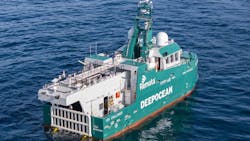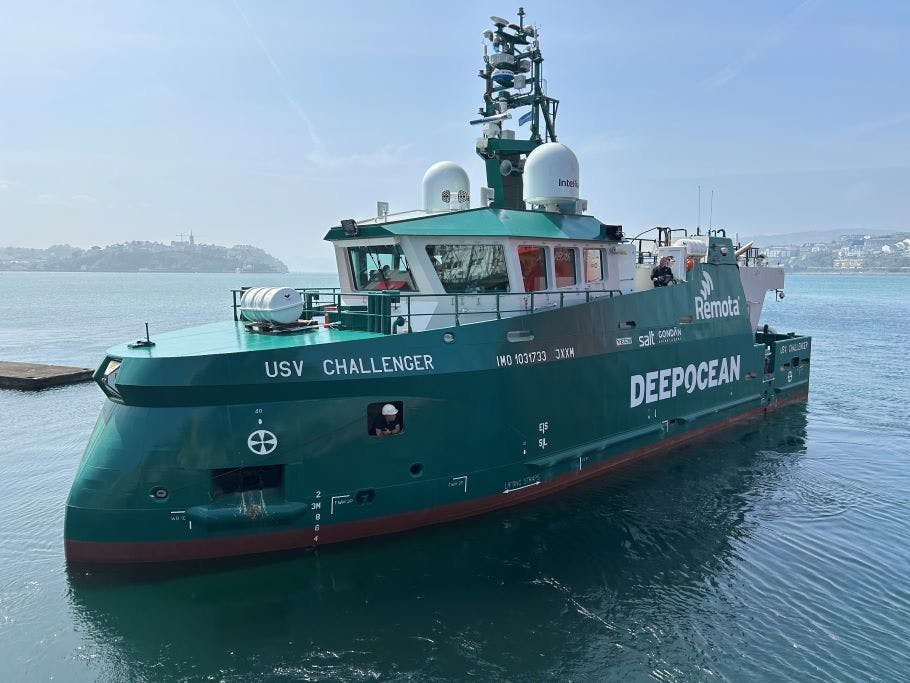DeepOcean takes delivery of uncrewed surface vessel for subsea operations
DeepOcean and its partners have taken delivery of a newbuild uncrewed surface vessel (USV) for subsea survey, inspection, maintenance and repair (IMR) work.
The USV Challenger, built by GONDAN Shipbuilders in Castropol, northern Spain, was due to arrive shortly at DeepOcean’s subsea base at Killingøy, Norway.
It will then undergo testing of the launch and recovery system for the onboard ROV and obtain maritime authority approval for its remote operating capabilities before starting a long-term charter for DeepOcean.
The 24-m-long, 7.5-m-wide vessel, designed by Salt Ship Design, features a hybrid diesel-electric propulsion system and can operate uncrewed at sea for up to 30 days.
Its owner is the USV AS joint venture between Solstad Offshore, Østensjø Rederi and DeepOcean, established to invest in and own uncrewed vessels. It will be controlled remotely from shore, with multiple autonomous features, and it is designed to withstand severe weather conditions.
During operations, both the USV maritime crew and ROV operators will be based in the same remote operating center at Killingøy.
According to DeepOcean CEO Øyvind Mikaelsen, the USV Challenger can perform subsea operations independently, and it can also support larger subsea vessels.
“Rather than mobilizing large vessels for every offshore task, operators can leverage the USV and its onboard ROV for parts of subsea installation, survey or IMR scope," Mikaelsen said. "By reducing the need for repeated transits of larger vessels, the USV offers significant cost savings.”
Its fully electric work class ROV, with hydraulic capabilities, will be capable of operating in waters up to 1,500 m deep, with a tool package to enable a wide range of subsea operations.
The ROV also has sensors for pipeline survey operations, seabed mapping and annual inspection work including measurements and cleaning. In addition, it can provide visual inspection support for a larger host ROV in congested and high-risk operating environments, or undertake 3D scanning of subsea facilities.
To support subsea inspections, the ROV has the same software as DeepOcean’s autonomous inspection drone, allowing it to conduct pre-programmed inspections of subsea assets. In seabed areas with low visibility, the company’s digital twin platform allows the ROV operator to instead fly and operate the vehicle in the digital twin.
Among other capabilities, the ROV is designed to open hatches on subsea templates, perform repairs, use torque tools on subsea equipment, run cleaning tools and conduct leak measurements. It can also connect and disconnect flying leads and provide touchdown support for cable-lay operations.
The DeepOcean-designed launch and recovery system comprises an electrical winch, a sheave wheel trolley, kicker and rear hatch. Launch and recovery of the ROV takes place over the stern of the USV.
During launching, the ROV is pushed in while the USV moves forward. For recovery, the ROV is pulled in like a trawl operation while the boat moves forward.
About the Author
Jeremy Beckman
Editor, Europe
Jeremy Beckman has been Editor Europe, Offshore since 1992. Prior to joining Offshore he was a freelance journalist for eight years, working for a variety of electronics, computing and scientific journals in the UK. He regularly writes news columns on trends and events both in the NW Europe offshore region and globally. He also writes features on developments and technology in exploration and production.


